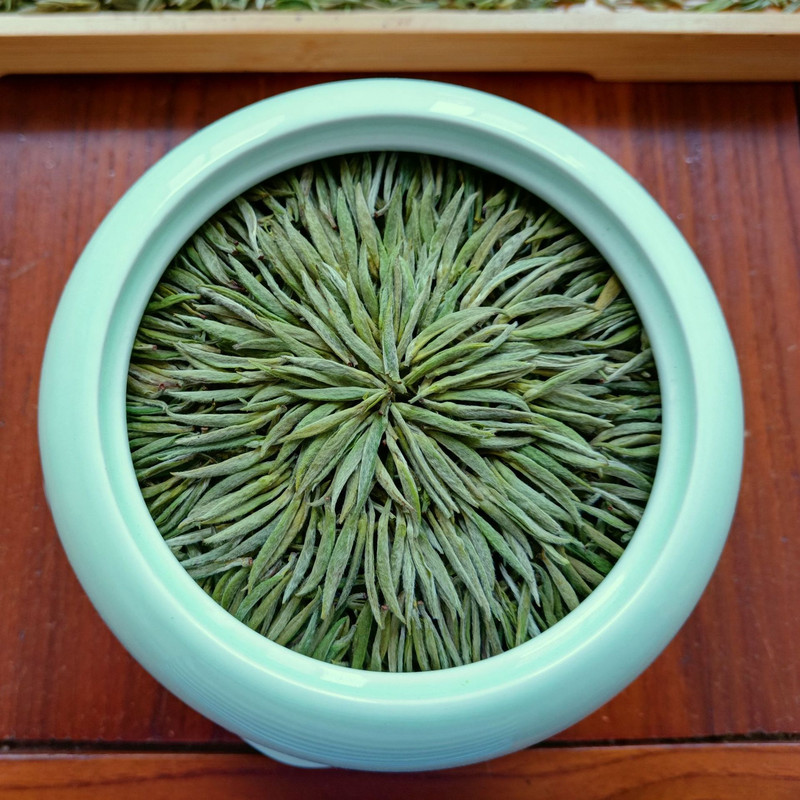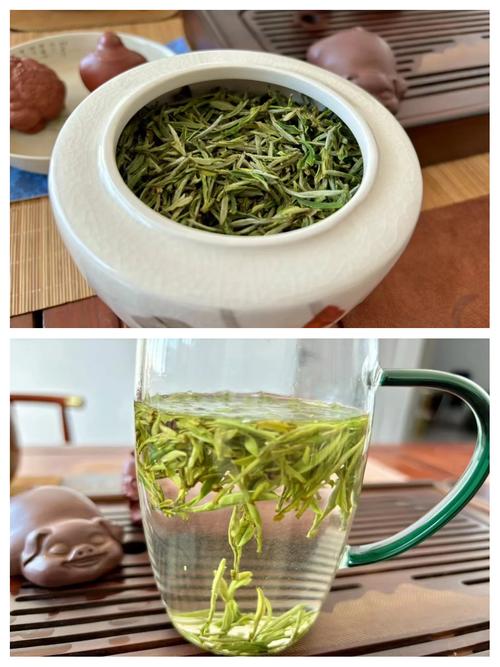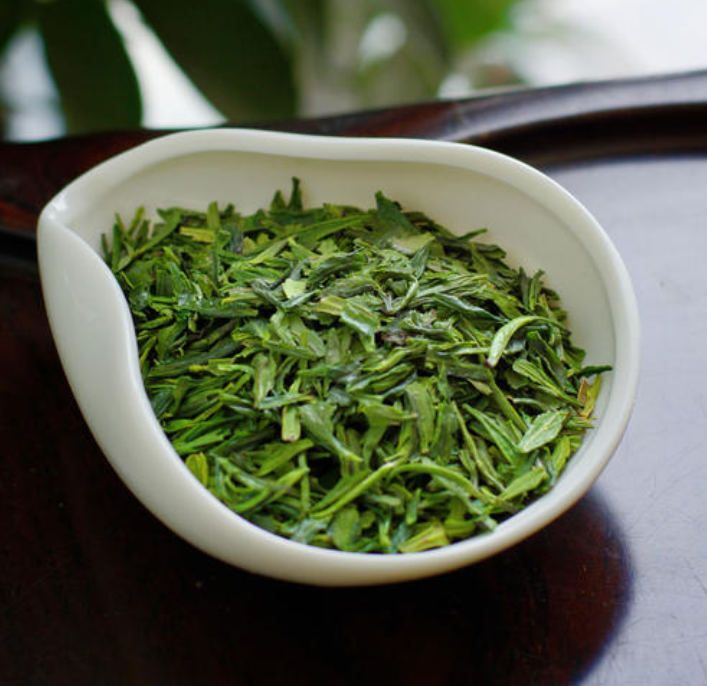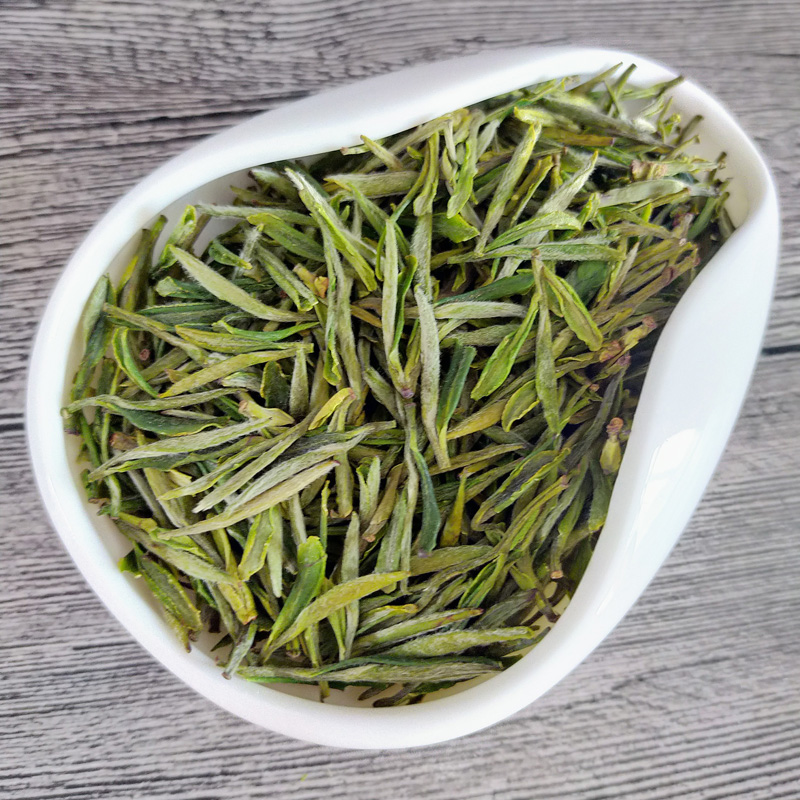Nestled in the mist-clad valleys of China’s southern highlands, where ancient tea forests guard secrets of centuries past, emerges a tea as sharp and revered as the legendary blade it resembles: 九山翠剑 (Jiǔshān Cuìjiàn), or “Jade Sword of Nine Mountains.” This emerald-green tea, celebrated for its distinctive flat, needle-like shape and crisp flavor, has been a testament to China’s tea-making mastery since the Ming Dynasty.

A Legacy Forged by Emperors and Poets
The story of Jiushan Cuijian begins in the 15th century, when it was first presented as a tribute to the Yongle Emperor, who praised its “emerald hue and sword-like spirit.” Grown in regions like Guizhou’s Meitan County—a historic tea hub dubbed the “Little Jiangnan of Guizhou”—this tea thrives in lush, fog-draped valleys where terroir imparts it with mineral-rich complexity. Today, Jiushan Cuijian is revered as a living relic of China’s tea heritage, embodying the harmony between nature and human craft.
Artistry in Every Leaf
Jiushan Cuijian’s creation is a meticulous 14-step process, passed down through generations:
- Cultivation: Tea bushes grow in high-altitude gardens (800–1,200 meters), nurtured by humid subtropical air and red laterite soils.
- Plucking: Only the tenderest buds and one leaf are hand-selected in early spring, before Qingming Festival.
- Withering: Fresh leaves are air-dried on bamboo trays to reduce moisture.
- Fixation (杀青): Leaves are stir-fried in woks at 110–130°C to halt oxidation, preserving emerald hues.
- Shaping: Artisans press and roll leaves into “sword” shapes using palm friction, mimicking the blade’s edge.
- Drying: Three stages of low-temperature roasting (60–70°C) lock in aroma.
- Sorting: Master tea makers handpick debris, ensuring uniformity.
Aesthetic and Sensory Delight
The finished tea dazzles with its appearance: flat, jade-green strips resembling a sword’s edge, adorned with silvery fuzz. Brewed at 80–85°C, it unfurls to reveal:
- Aroma: Fresh orchid and chestnut notes with a hint of seaweed.
- Liquor: Luminous yellow-green, crisp and viscous.
- Flavor: A symphony of sweetness and umami, balanced by a lingering chestnut finish.
- Leaves: Plump, emerald-green buds with intact silver tips.
Brewing Ritual
To honor its complexity:
- Use 3g of tea per 150ml glass or porcelain vessel.
- Pre-warm the pot with 85°C water, discard, then add leaves.
- Infuse for 30 seconds, adjusting for subsequent brews (total 3–4 infusions).
- Observe the “dancing needles”—leaves that stand erect before settling gracefully.
Authenticity and Grading
Genuine Jiushan Cuijian is distinguished by:
- Appearance: Flat, slender blades without broken tips.
- Color: Vibrant jade-green hue (not dull or yellowed).
- Aroma: Fresh, not grassy or stale.
Grading follows strict standards:
- Supreme Grade: Entirely composed of silvery buds (≥45,000 tips/kg).
- Special Grade: One bud with a tender leaf (≥25,000 tips/kg).
- Premium Grade: One bud with two leaves.
Prices range from ¥800–¥2,500/500g for supreme grades, reflecting its labor intensity and limited yield (≈10kg per mu annually).
Healthful Elixir
Rich in catechins (28–34%) and L-theanine, Jiushan Cuijian offers:
- Antioxidant defense against free radicals.
- Metabolic support, aiding weight management.
- Mental clarity, with 25–35mg caffeine per cup.
- Oral health benefits, inhibiting plaque bacteria.
Legacy and Contemporary Reverence
Jiushan Cuijian transcends its role as a beverage—it is a cultural artifact. Ancient poets praised it as “jade dew in a cup,” while modern connoisseurs seek it for state banquets and gifts. As climate-resilient cultivars emerge, this tea remains a testament to China’s agrarian heritage, its sword-like leaves piercing through time to delight modern palates.
In every sip, one tastes not just tea, but the mist of Nine Mountains, the patience of generations, and the enduring spirit of China’s tea masters.



